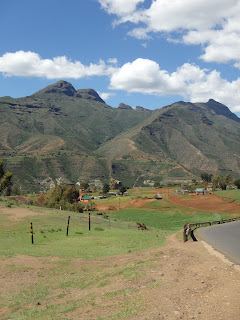 My district, Butha Butha, is also known as Mabita, which in
Sesotho is a nickname that roughly translates to Two Bs. Since most people call
it BB, Mabita is fitting slang. Although the district bridges the gap between
the lowlands and highlands, it offers incredible views and a lot of diversity in
climate. Possible adventures include Afriski and Oxbow, Liphofung Caves, Muela
Dam and Lodge, and Tsetlanyane.
My district, Butha Butha, is also known as Mabita, which in
Sesotho is a nickname that roughly translates to Two Bs. Since most people call
it BB, Mabita is fitting slang. Although the district bridges the gap between
the lowlands and highlands, it offers incredible views and a lot of diversity in
climate. Possible adventures include Afriski and Oxbow, Liphofung Caves, Muela
Dam and Lodge, and Tsetlanyane.
Arriving at Liphofung Caves via public transportation begins
with incredible views of traditional homes and incredible mountains. The caves
sit just before the transition from Lesotho’s lowlands to the highlands, so the
mountains are taller and more striking. The taxi drops off along the main paved
road through the district. On my first visit, I was dropped at the sign for
Liphofung, which sits next to a 2km cement road that leads to the historical
site, which seems short enough until you realize the weight of the food, drink,
and luggage for the three day Christmas celebration you are set to enjoy, then
the trek is brutal. My second visit I was on a taxi with a driver I know. He
instead dropped us at a path much closer to the caves and we arrived in
minutes.
 The site has been well established as a small destination. In
addition to guided tours of the cave site, they have an educational room and a
small three-building cultural village to show how Basotho traditionally lived,
cooked, and dressed. The shop sells only hand-made items from Lesotho. There
are also a handful of beautiful self-catering chalets for overnight accommodation.
The site has been well established as a small destination. In
addition to guided tours of the cave site, they have an educational room and a
small three-building cultural village to show how Basotho traditionally lived,
cooked, and dressed. The shop sells only hand-made items from Lesotho. There
are also a handful of beautiful self-catering chalets for overnight accommodation.
As the tour begins, the guide escorts us down the rocks and
steps over a beautiful waterfall. As we enter the cave he points out a spring
that always has water and a small rock wall that was used by local herdboys
when they kept their animals in the cave before it became a cultural site.
From there, we head into the cave area. Caves in Lesotho are
not the deep, dark caverns that Americans typically think of. They are
generally more like overhangs with foliage and sunlight. At Liphofung, the caves are stunning with a
beautiful waterfall, weaver nests, and plants rarely seen in Lesotho as they
require more water than the dry season typically allows to grow.
We stop at the wall of San paintings and the guide explains
the significance of the paintings. The paints were done by the traditional
healers or Shamans of the San people after fasting and dreaming. The Eland-the
largest of antelopes in Africa-was prized by the San people and appears in many
of the drawings. The images of only the hind quarter of the Elands represent
the animals passing through the rock wall into the afterlife. There are images
of people curled up or sitting, representing sick people. After they touch the
nose of the Eland, they are upright, which shows healing.
We then climb up and out of the caves to visit the cultural
village. We enter the cooking rondeval first. There we are shown the
traditional cooking tools and clay pots of the Basotho-many of which have been
replaced by plastic and cast iron. We are shown a cross shaped cooking hearth,
designed to allow outdoor cooking regardless of wind direction—this too has
been replaced in the modern age, this time by half of a metal barrel which can
be moved to block the wind.
The second rondeval we enter is that of the parents. It
shows two beds comprised of animal skins and mats. The guide demonstrates a variety
of cultural clothing-the small skirts for unmarried girls, the additional skins
a married woman wears, the small covers boys would wear and those that men
would wear. He then picks up a animal skin hat and explains the Chief would
wear it.
While there, he elaborates on the traditional sleeping
arrangements of the Basotho. The parents would share one rondeval. Older boys
would sleep near the animals. The older girls would sleep in the kitchen hut.
The younger children and the grandmothers would sleep in another hut, where the
grandmothers would entertain them with traditional stories.
Our last stop is the educational building, where the guide
shows us traditional tools and musical instruments of the Basotho. We then take
a few minutes to read the educational placards elaborating on the history of
the area and the value of the Highlands Water Project, paid for the creation of
the cultural site.










No comments:
Post a Comment